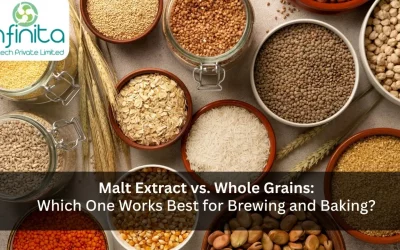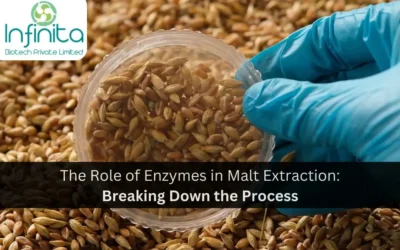Malt is a key ingredient in the production of beer, providing the necessary enzymes for the conversion of starches into fermentable sugars. Understanding the chemistry of enzymes is essential to unlocking the secrets of malt extraction, and this knowledge has the potential to revolutionize the brewing industry. In this article, we will delve into the fascinating world of enzymes, exploring their role in biological processes, the science behind malt extraction, the connection between enzymes and malt extraction, advanced concepts in enzyme chemistry, and future perspectives in enzyme and malt research.
Understanding Enzymes: A Basic Overview
Enzymes are biological molecules that act as catalysts, speeding up chemical reactions without being consumed in the process. They play a crucial role in almost every metabolic process in living organisms. Enzymes are typically large proteins made up of amino acids that fold into complex three-dimensional structures. Each enzyme is specific to a particular reaction, and the reaction it catalyzes is determined by its unique shape and chemical properties.
The Role of Enzymes in Biological Processes
Enzymes are essential for the proper functioning of cells. They are responsible for breaking down large molecules into smaller ones, synthesizing new molecules, and carrying out the countless chemical reactions necessary for life. Enzymes are involved in processes such as digestion, respiration, DNA replication, and immune system responses. Without enzymes, these processes would be prohibitively slow or even impossible.
Different Types of Enzymes and Their Functions
There are thousands of different enzymes, each with its specific function. They are classified into several categories based on the type of reaction they catalyze. Some enzymes, known as hydrolases, break down molecules by adding water. Examples of hydrolases include amylase, which breaks down starch, and lipase, which breaks down lipids. Other types of enzymes include oxidoreductases, transferases, and ligases, each playing a distinct role in cellular chemistry.
Let’s take a closer look at oxidoreductases. These enzymes are involved in oxidation-reduction reactions, where electrons are transferred between molecules. One example of an oxidoreductase is cytochrome c oxidase, which is crucial for cellular respiration. It helps in the final step of the electron transport chain, transferring electrons to oxygen and producing water as a byproduct. Without cytochrome c oxidase, the process of generating energy in the form of ATP would be severely impaired.
Another important group of enzymes is transferases. These enzymes facilitate the transfer of functional groups, such as a phosphate or a methyl group, from one molecule to another. An example of a transferase is DNA methyltransferase, which adds a methyl group to DNA molecules. This process is essential for gene regulation and plays a role in determining which genes are turned on or off in a cell. Without DNA methyltransferase, the regulation of gene expression would be disrupted, leading to various cellular dysfunctions.
The Science Behind Malt Extraction
Malt extraction is a complex process that involves the conversion of the starches found in the barley grain into fermentable sugars. Enzymes are the key players in this process, breaking down the starch molecules into smaller sugar molecules that yeast can readily metabolize. Understanding the science behind malt extraction is crucial for optimizing the brewing process and ensuring the production of high-quality malt.
Delving deeper into the world of malt extraction reveals a fascinating interplay of biochemical reactions and physical transformations. The enzymes present in malt, such as alpha-amylase and beta-amylase, act as biological catalysts, accelerating the breakdown of complex starches into simpler sugars. This enzymatic activity is finely tuned by factors like temperature and pH, highlighting the delicate balance required for successful malt extraction.
The Process of Malt Extraction
Malt extraction begins with the malting of barley grains. During malting, the grains are soaked in water and allowed to germinate. This activates the enzymes naturally present in the barley. The germinated grains are then kiln-dried to stop the germination process without killing the enzymes. These dried grains, known as malt, are rich in enzymes such as alpha-amylase and beta-amylase, which are responsible for breaking down the starches into sugars.
As the malted barley is introduced to the mashing process, a carefully controlled dance of temperature and enzyme activity ensues. The mash tun provides the ideal environment for the enzymes to work their magic, converting starches into a sugary wort that will serve as the foundation for the brewing process. This crucial step sets the stage for fermentation, where yeast will further metabolize the sugars to produce alcohol and carbon dioxide.
Key Factors Influencing Malt Extraction
Several factors influence the efficiency of malt extraction. The quality of the barley used, the malting process, and the conditions during mashing all play a role in determining the amount of fermentable sugars that can be extracted from the malt. Factors such as temperature, pH, and enzyme activity need to be carefully controlled to achieve optimal malt extraction and ensure consistent brewing results.
Furthermore, the choice of malt variety can also impact the flavor profile of the final beer. Different malts bring unique characteristics to the brew, ranging from subtle caramel notes to rich chocolate undertones. Brewers often experiment with various malt combinations to achieve the desired flavor complexity and balance in their creations, showcasing the artistry that goes hand in hand with the science of malt extraction.
The Connection Between Enzymes and Malt Extraction
The relationship between enzymes and malt extraction is a symbiotic one. Enzymes are essential for the conversion of starches into sugars, while malt provides the enzymes necessary for this process. By understanding the specific enzymes involved in malt extraction, brewers can manipulate the brewing process to achieve desired outcomes and create unique flavors and aromas in their beers.
Enzymes are biological catalysts that accelerate chemical reactions without being consumed in the process. In the context of malt extraction, enzymes act on the starches present in the malted grains, breaking them down into fermentable sugars that yeast can metabolize during fermentation. This crucial step not only provides the necessary fuel for yeast to produce alcohol but also contributes to the body, mouthfeel, and overall sensory characteristics of the final beer.
Enzymes Involved in Malt Extraction
The two key enzymes involved in malt extraction are alpha-amylase and beta-amylase. Alpha-amylase hydrolyzes the starch molecules into shorter chains of glucose, maltose, and dextrins, while beta-amylase further breaks down maltose into glucose. These enzymes work in synergy to ensure the efficient conversion of starches into fermentable sugars.
Aside from alpha-amylase and beta-amylase, other enzymes such as limit dextrinase and proteases also play important roles in the malt extraction process. Limit dextrinase helps in breaking down larger dextrins into smaller, more fermentable sugars, while proteases assist in protein degradation, which can impact the clarity and stability of the final beer. Understanding the interplay of these enzymes is crucial for brewers to fine-tune their mashing schedules and optimize sugar extraction efficiency.
The Impact of Enzymes on Malt Quality
Enzymes play a significant role in determining the quality of malt. The activity and specificity of the enzymes present in the malt influence the composition of the sugars produced during mashing and, subsequently, the flavor and fermentability of the resulting beer. Brewers carefully select malt varieties with specific enzyme profiles to achieve desired brewing outcomes and ensure consistency in their beer production.
Moreover, the temperature and pH conditions during mashing can also influence enzyme activity and, consequently, the sugar profile of the wort. By controlling these parameters, brewers can modulate the enzymatic activity to tailor the beer’s characteristics, such as sweetness, body, and alcohol content. This intricate balance between enzymes, malt composition, and brewing parameters underscores the art and science of brewing, where meticulous attention to detail can lead to extraordinary beer creations.
Advanced Concepts in Enzyme Chemistry
While understanding the basics of enzyme chemistry is essential, delving into advanced concepts provides further insights into the intricacies of enzyme reactions and their application in malt extraction.
Enzyme Kinetics and Malt Extraction
Enzyme kinetics is the study of the rates at which enzymes catalyze reactions. Understanding enzyme kinetics allows brewers to optimize the mashing process by controlling factors such as enzyme concentration, temperature, and substrate concentration. By manipulating these variables, brewers can fine-tune the efficiency of starch conversion, leading to improved malt extraction and ultimately better beer.
Enzyme Inhibition and Malt Extraction
Enzyme inhibition refers to the process by which enzyme activity is hindered or slowed down. In the context of malt extraction, enzyme inhibition can be both beneficial and detrimental. Controlling enzyme inhibition enables brewers to modulate the mashing process and achieve desired characteristics in their beers. Understanding the factors that influence enzyme inhibition is key to mastering the art of malt extraction.
Future Perspectives in Enzyme and Malt Research
The study of enzymes and their role in malt extraction continues to evolve, offering exciting possibilities for the brewing industry. Technological advances and a deeper understanding of enzyme chemistry open up new avenues for research and innovation in malt production.
Technological Advances in Enzyme Research
New techniques and tools are being developed to study enzymes at the molecular level, allowing researchers to gain a deeper understanding of their structure and function. These advancements enable the identification and engineering of enzymes with enhanced properties, further enhancing the efficiency and specificity of malt extraction.
Potential Applications of Enzyme Knowledge in Malt Production
The knowledge gained from studying enzymes has the potential to revolutionize malt production. By harnessing the power of enzymes, brewers can develop innovative methods for malt extraction, leading to improved flavors, increased efficiency, and reduced environmental impact. Enzyme-based processes may also offer the opportunity to produce specialty malts with unique characteristics.
In conclusion, the chemistry of enzymes plays a vital role in unlocking the secrets of malt extraction. Understanding the role of enzymes in biological processes, the science behind malt extraction, the connection between enzymes and malt extraction, advanced concepts in enzyme chemistry, and future perspectives in enzyme and malt research opens up new possibilities for the brewing industry. By harnessing the power of enzymes, brewers can optimize the brewing process, create unique flavors, and contribute to the continued advancement of malt production.







